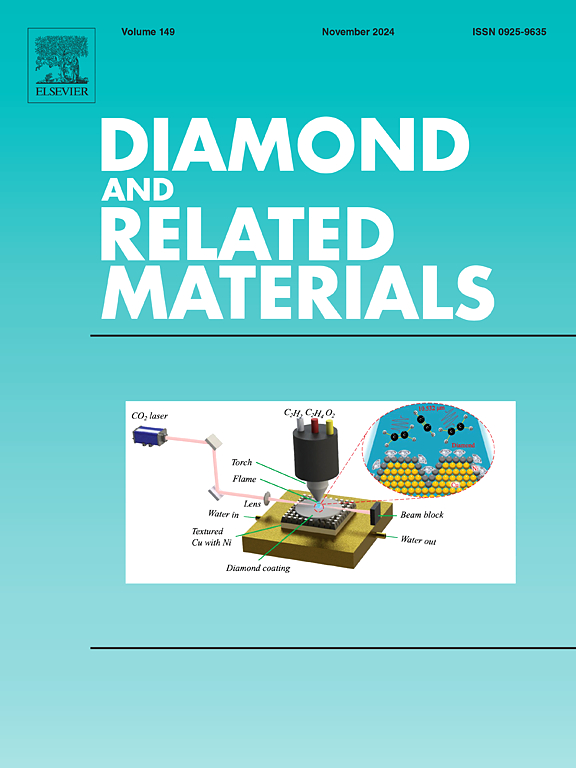Facile design of N-rich g-C₃N₅/NiFe2O4 heterojunction for visible-light-driven photo-Fenton RhB degradation and photocatalytic hydrogen evolution
IF 5.1
3区 材料科学
Q2 MATERIALS SCIENCE, COATINGS & FILMS
引用次数: 0
Abstract
The need for effective and eco-friendly solutions to address dye pollution and hydrogen (H2) generation has driven research into visible-light-responsive photocatalysts. This study presents the synthesis of a novel nanocomposite, combining triazole-derived graphitic carbon nitride (g-C3N5) with nickel ferrite (NiFe2O4), prepared through a facile wet-chemical approach using 3-amino,1,2,4-triazole as a precursor. This composite is specifically designed for visible-light-driven photo-Fenton-like dye degradation and H2 evolution without the necessity for precious metal co-catalysts. Characterization techniques, including X-ray diffraction (XRD), confirmed the successful synthesis of the nanocomposite by revealing distinct peaks corresponding to both NiFe2O4 and g-C3N5, indicating phase purity. Transmission electron microscopy (TEM) and high-resolution transmission electron microscopy (HRTEM) demonstrated the uniform deposition of NiFe2O4 nanoparticles on the g-C3N5 nanosheets, while energy-dispersive X-ray (EDX) spectroscopy confirmed the presence of nickel and iron in the composite. The NiFe2O4/N-rich g-C3N5 composite possessed a surface area of 131.11 m2/g, which is two times higher than that of pure NiFe2O4. Enhanced optical absorption and charge separation resulting from heterojunction formation significantly improved its photocatalytic efficiency. The NiFe2O4/g-C3N5 composite achieved 97 % degradation of rhodamine B dye within 40 min of visible-light exposure, compared to 13 % and 41 % for pure NiFe2O4 and N-rich g-C3N5, respectively. Additionally, it demonstrated superior H2 production, yielding 3247 μmol/g after 4 h of visible-light irradiation, outperforming pure g-C3N5 (2550 μmol/g) and NiFe2O4 (1127 μmol/g). The photocatalytic mechanism was explored using a band potential diagram and elemental trapping experiments. This is the first demonstration of NiFe2O4/N-rich g-C3N5driving both photo-Fenton dye degradation and H2 evolution without noble-metal co-catalysts. This work offers a viable pathway for developing efficient and scalable photocatalysts for environmental and energy applications.

用于可见光驱动光- fenton RhB降解和光催化析氢的富N- c₃N₅/NiFe2O4异质结的简易设计
需要有效和环保的解决方案来解决染料污染和氢(H2)的产生,推动了可见光响应光催化剂的研究。本研究以3-氨基,1,2,4-三唑为前驱体,采用湿法制备了一种新型纳米复合材料,将三唑衍生的石墨氮化碳(g-C3N5)与镍铁氧体(NiFe2O4)结合。这种复合材料是专门为可见光驱动的光fenton类染料降解和H2演化而设计的,而不需要贵金属共催化剂。表征技术,包括x射线衍射(XRD),通过显示NiFe2O4和g-C3N5对应的明显峰,证实了纳米复合材料的成功合成,表明相纯度。透射电子显微镜(TEM)和高分辨率透射电子显微镜(HRTEM)证实了NiFe2O4纳米颗粒在g-C3N5纳米片上均匀沉积,而能量色散x射线(EDX)光谱证实了复合材料中镍和铁的存在。NiFe2O4/富n - g- c3n5复合材料的表面积为131.11 m2/g,是纯NiFe2O4的2倍。异质结的形成增强了光吸收和电荷分离,显著提高了其光催化效率。在可见光照射40 min内,NiFe2O4/g-C3N5复合材料对罗丹明B染料的降解率达到97% %,而纯NiFe2O4和富n - g-C3N5的降解率分别为13% %和41% %。此外,在4 h的可见光照射下,其产氢量为3247 μmol/g,优于纯g- c3n5(2550 μmol/g)和NiFe2O4(1127 μmol/g)。通过带势图和元素捕获实验探讨了光催化机理。这是首次证明富NiFe2O4/ n - g- c3n5在没有贵金属辅助催化剂的情况下同时驱动光- fenton染料降解和H2生成。这项工作为开发高效、可扩展的环境和能源光催化剂提供了一条可行的途径。
本文章由计算机程序翻译,如有差异,请以英文原文为准。
求助全文
约1分钟内获得全文
求助全文
来源期刊

Diamond and Related Materials
工程技术-材料科学:综合
CiteScore
6.00
自引率
14.60%
发文量
702
审稿时长
2.1 months
期刊介绍:
DRM is a leading international journal that publishes new fundamental and applied research on all forms of diamond, the integration of diamond with other advanced materials and development of technologies exploiting diamond. The synthesis, characterization and processing of single crystal diamond, polycrystalline films, nanodiamond powders and heterostructures with other advanced materials are encouraged topics for technical and review articles. In addition to diamond, the journal publishes manuscripts on the synthesis, characterization and application of other related materials including diamond-like carbons, carbon nanotubes, graphene, and boron and carbon nitrides. Articles are sought on the chemical functionalization of diamond and related materials as well as their use in electrochemistry, energy storage and conversion, chemical and biological sensing, imaging, thermal management, photonic and quantum applications, electron emission and electronic devices.
The International Conference on Diamond and Carbon Materials has evolved into the largest and most well attended forum in the field of diamond, providing a forum to showcase the latest results in the science and technology of diamond and other carbon materials such as carbon nanotubes, graphene, and diamond-like carbon. Run annually in association with Diamond and Related Materials the conference provides junior and established researchers the opportunity to exchange the latest results ranging from fundamental physical and chemical concepts to applied research focusing on the next generation carbon-based devices.
 求助内容:
求助内容: 应助结果提醒方式:
应助结果提醒方式:


